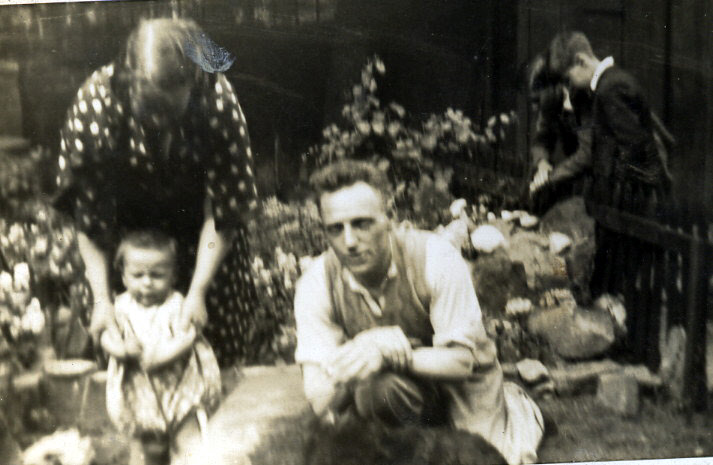
TONY JACKSON- EARLY YEARS
I entered this world on 31st October 1939. I have, therefore, often received comments relating to my character because my birthday is always on HALLOWEEN.
The earliest account I can relate occurred when I was 6 months old. My mother described it to me on more than one occasion. She said I became ill and went into convulsions ( some form of epileptic fit). Our doctor was called and he told my mother that I was unlikely to live through the night. Had he been correct there are an awful lot of lives that would have taken a different course. ( not least my children. Grand Children and Great Grand Children)
Where to begin? I suppose with the earliest photo I can find of me:

I guess I am about 9 months old here and the place is definitely 28, Pomona Street. Originally my parents lived at No. 26 but they did an exchange because No. 28 had a wood and glass kitchen extending to the rear of the house.
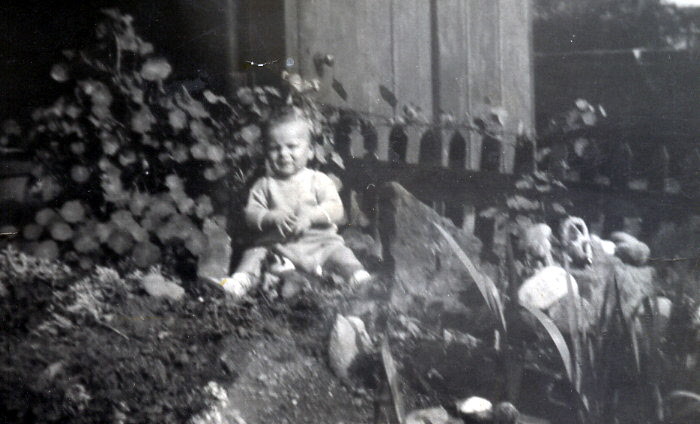
Here, again, the garden is Pomona Street. I know because I remember the shed in the next garden; the place I used to store my bike when I was older. The shed was actually opposite 26 Pomona Street but strangely the land on which it stood was part of No.28. Hence, my father, years later built a garage on it. My age? 15 months?
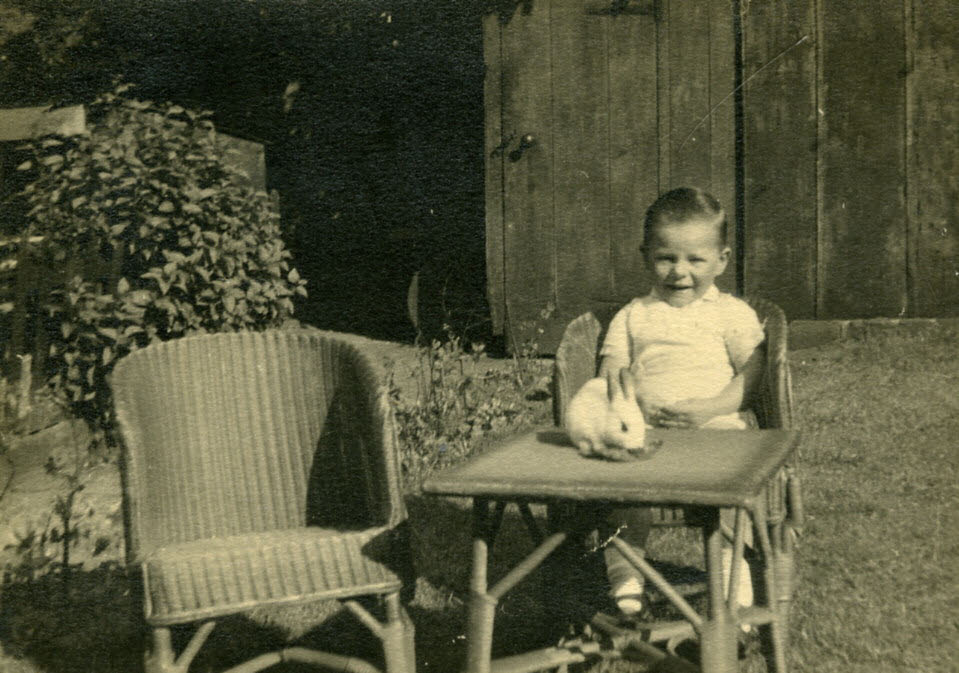
I can't remember the rabbit but I can certainly remember the table and chairs which were toys for many years.
Any suggestions for my age here?
I'll mention here, something about my mother's life that I omitted from her Web pages. About this time of my life my mother worked part-time at a grocer's shop at the bottom of Pomona Street called GILLAMS.
My mother was very friendly with the owner, Mrs Gillam, who had a daughter slightly older that me. Her name was Anthea:
Here we are together in her back garden.
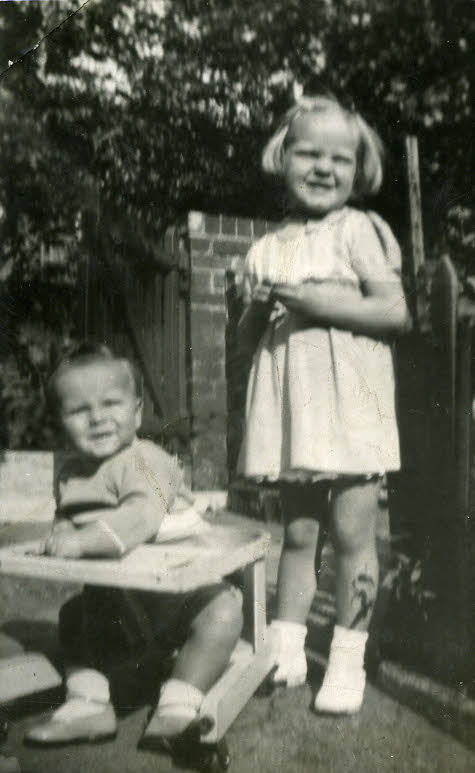
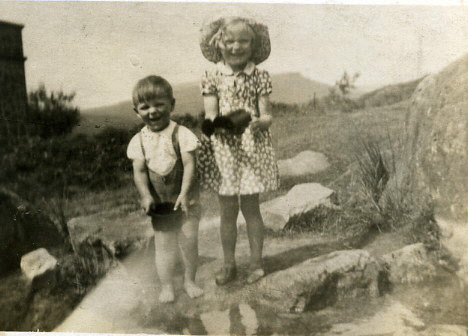
And in this photo we are at Fox House.
Quite often, whilst my mother was serving in the shop, Mrs Gillam would look after me at her house at No. 27 Pomona St. Owning a shop, I suppose they were relatively well-off and were the only people I knew who owned a television. I spent many a happy hour there watching Muffin the Mule. If that confuses you then Google the programme.
Another memory of their house was having my tea there one day. I was given something I'd never seen before:

Bananas were being brought into the country during the 1940's and were considered to be a luxury.
Throughout this early period of my life our country was at war with Germany. Food and goods of all description were in very short supply. This did not mean we had to go without. My father, who had very little school education, was not lacking in intelligence and ability.
In times of such short supply just how did he come up with a birthday present like this for me?:
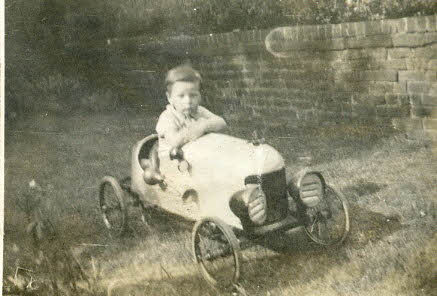
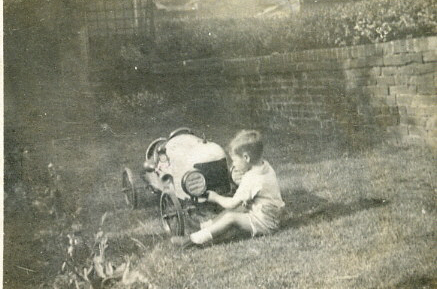
I know he bought it second hand but don't remember if he ever told me who from. (and the headlights worked)
Another example of his ingenuity came about because of the shortage of protein type food, particularly meat and eggs.
He was determined we should not go short and built a hen house in our back garden. I can remember feeding the chickens with bran and potato peelings and been chased out of the shed by a bad-tempered cockerel. My father also kept ducks in the back garden. When the time came to get rid of them my parents lied and told me they had gone to live on a farm. Such was my love for animals they hadn't the heart to tell me they had been killed.
Other animals I remember owning at Pomona St. were: cats, guinea pigs, hamsters, rabbits, and goldfish in a back garden pond. The pond was actually on the property of No. 26. It was constructed of concrete and placed in the hole left by the Anderson Shelter, after the Germans stopped bombing us.
After reading up to this point my son, Dean asked for more information about 28 Pomona Street. He remembered going to see his Nan there many times but couldn't remember the exact layout of the house.
To help him I have drawn a plan and included it here:
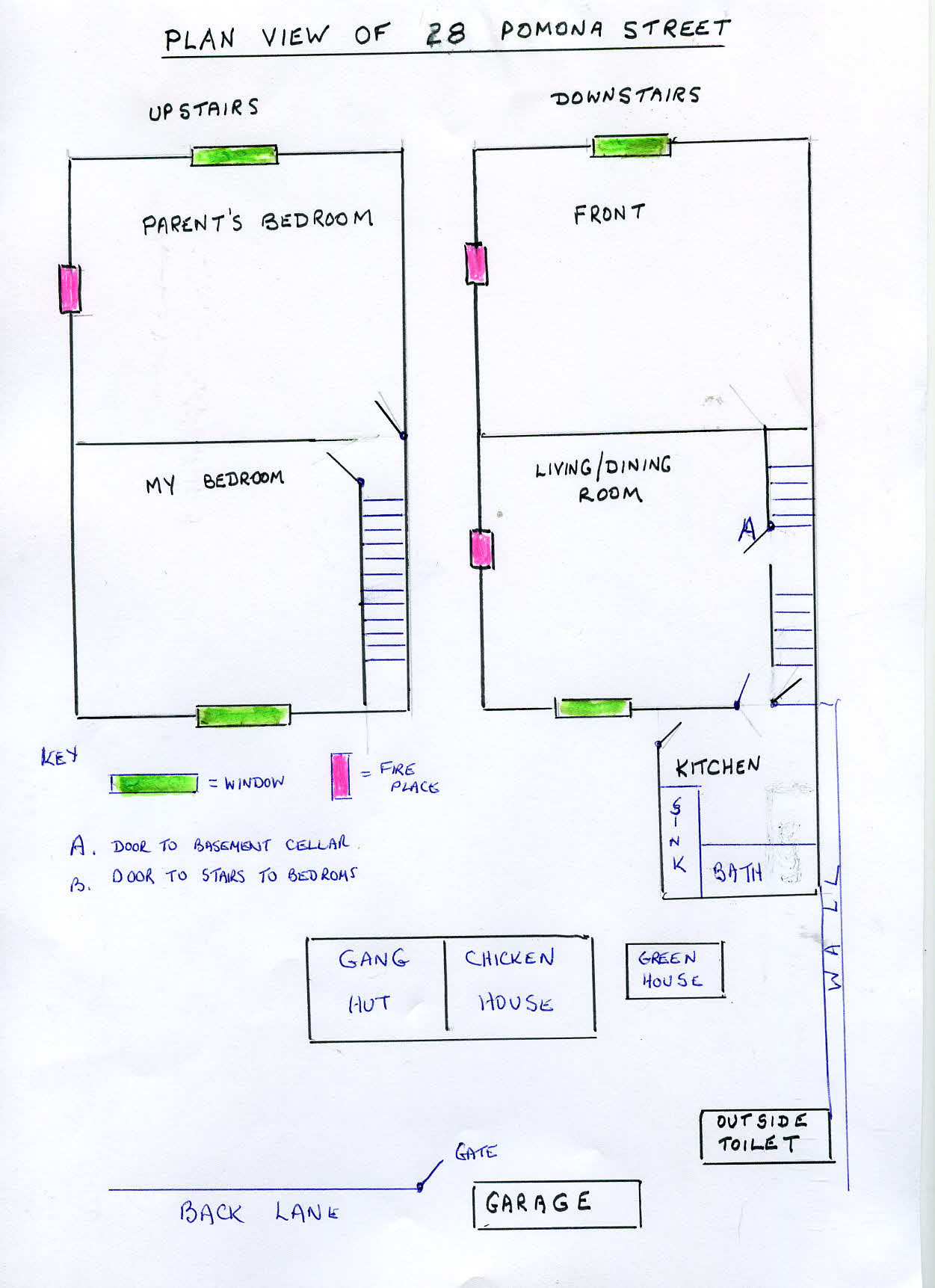
Would like to think of a caption for this photo but will leave it for someone else:
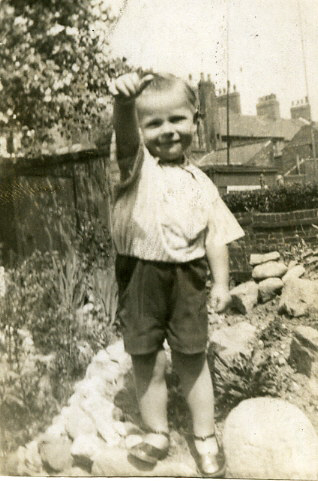
It was taken in the garden of No. 26 Pomona St. and I would guess I am stood on the earth and bricks covering the air-raid shelter. People used to pile things on their shelters hoping to give them more protection from a bomb blast.
Many of the Jackson and Hurt families, past and present, were and are animal lovers. My mother and I were obsessed with care and love for them. This photo (taken about 1949) shows the first dog I ever owned. His name was Rex.
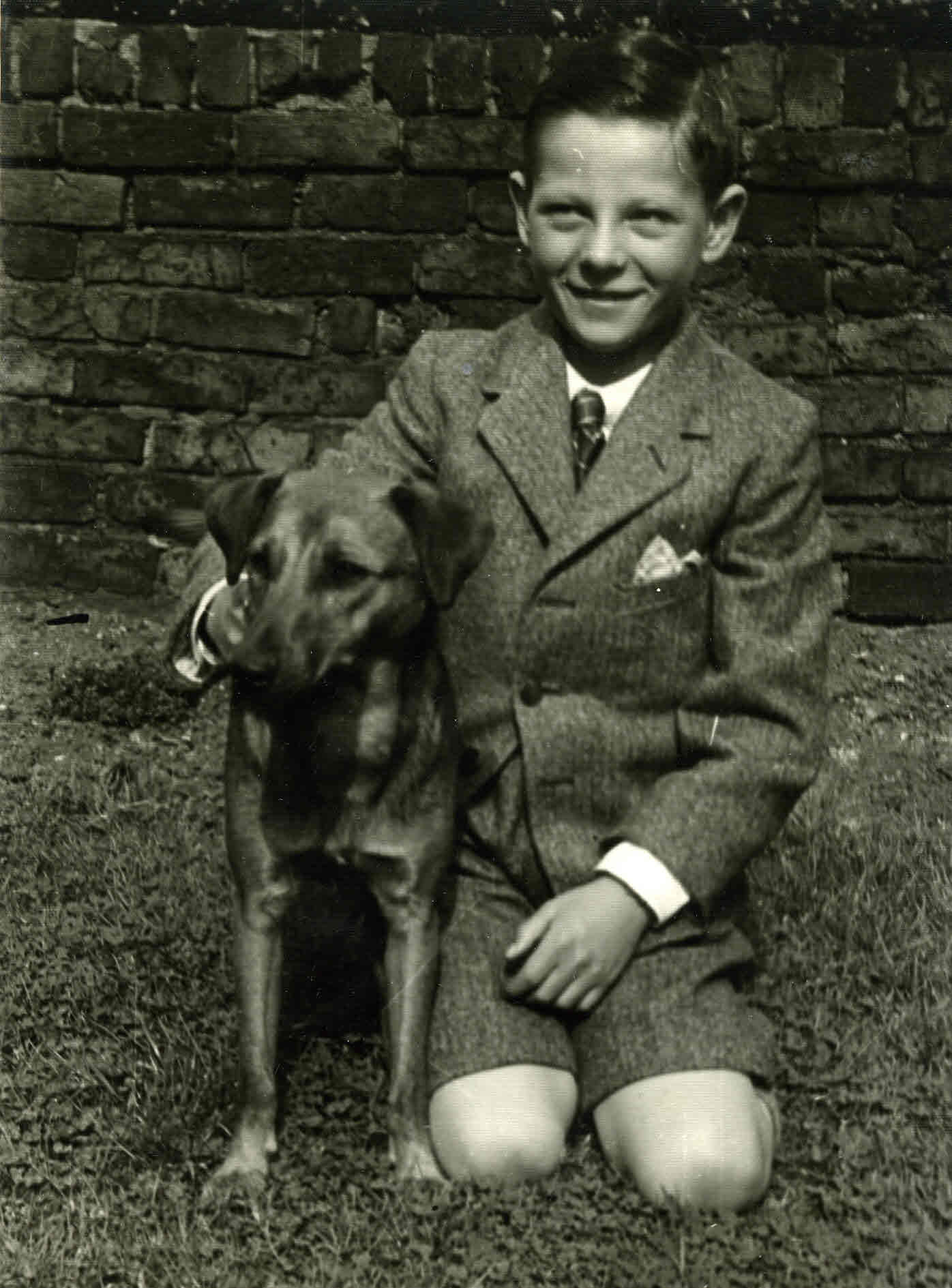
Rex came to a sad end. On returning from a holiday with a friend and his mother and father I was told that Rex had run out of the house, down our back lane and then run in front of a car in Summerfield St: Never mind he was reincarnated 60 years later:
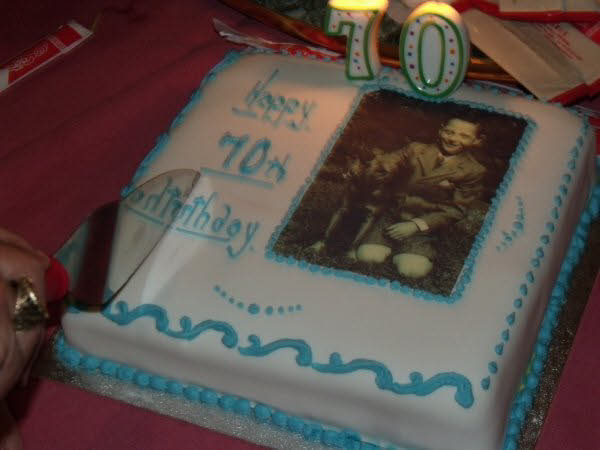
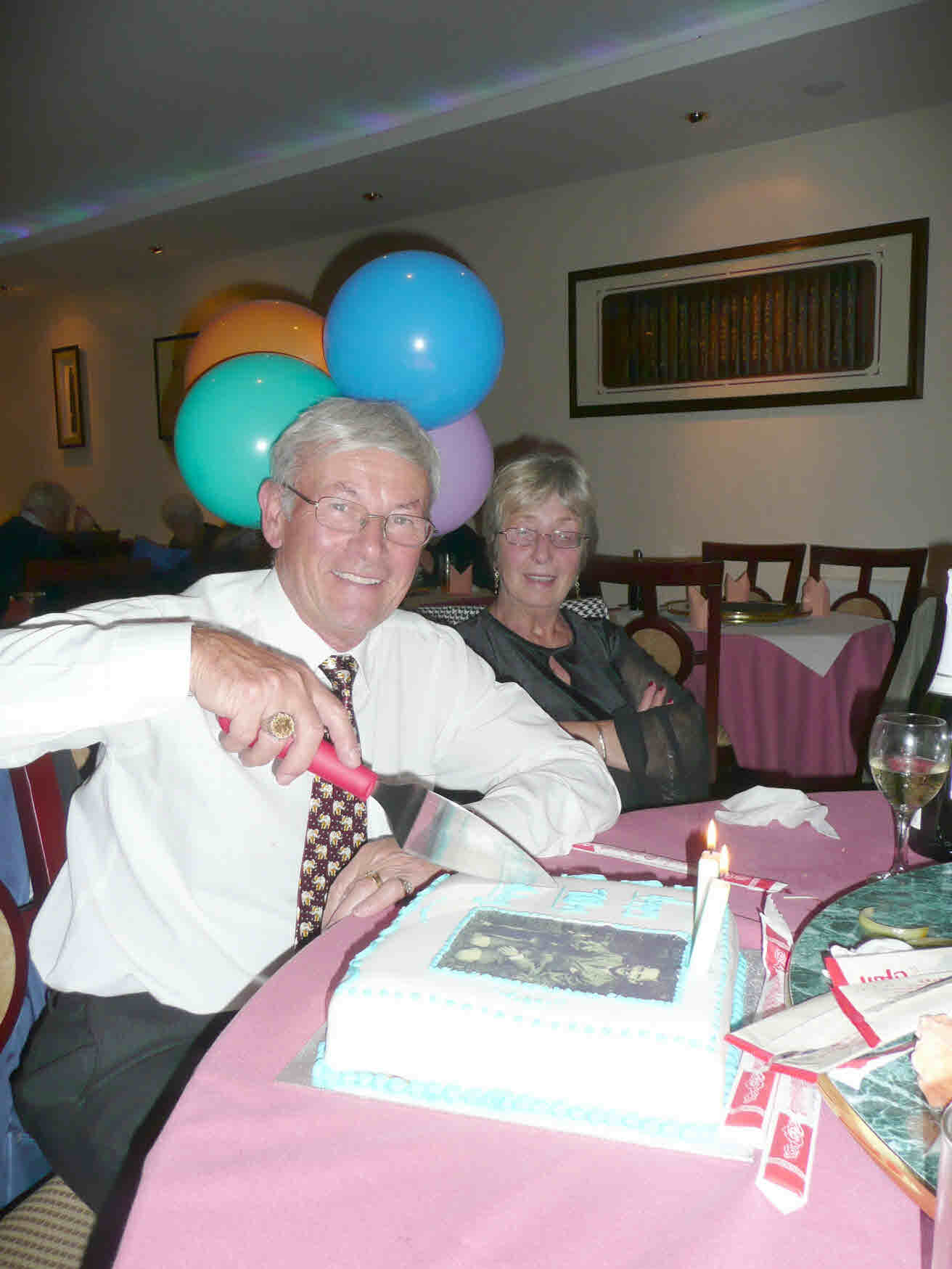
At this age I was very mischievous:
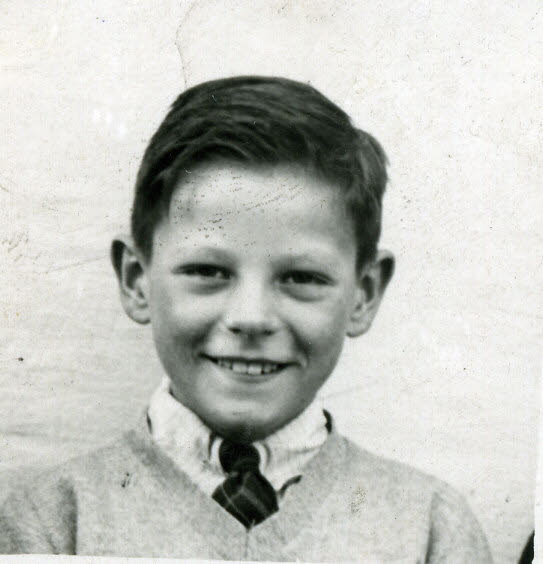
Next door (No. 26) to our house lived an elderly lady called
Henrietta Shillito.
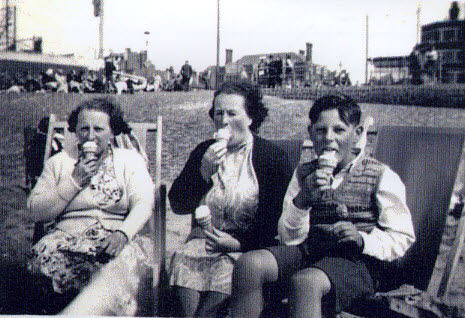
She's on the left here.
My favourite trick was to sneak into her house when she was in her front room. I would hide behind the door leading to her upstairs and wait there for ages until she returned to her livIng-room. I would then leap out from behind the door and shout "BOO". The poor lady would nearly jump out of her skin. My mother used to say I would give her an heart attack. Years later she did die of an heart attack but thankfully not because of my devilment.
Hetty had a son called Brian who lived with her. He was older than me, went to Firth Park Grammar School and could speak Russian fluently. This allowed him to get a well-paid job at the Foreign Office.
Brian was very keen on push-bikes and encouraged me to get one. I remember our first trip out together when we cycled to Fox House. It was quite a way for my first ever ride and I could hardly believe it when at one stage he said we will be cycling uphill for the next 5 miles.
Our trip was not without excitement. Just before reaching Fox House we paused for a rest. We stood our bikes against a stone wall and went into the moors to explore.
It was not long before we found a 12inch unexploded shell lying in the heather. We left the scene very quickly but never did tell anyone what we had found.
My father had purchased our house and No. 26 ( he also had the option of purchasing No. 24 but declined because my mother said they were a strange couple who lived there) so they had to find a new tenant when Hetty died. My mother chose a good friend of hers who had just lost her husband. The lady was called Ann Goddard:
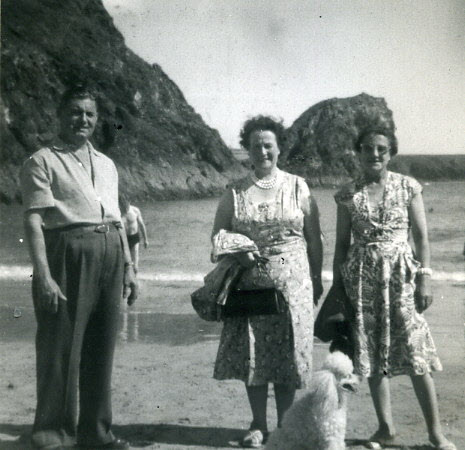
She is on the right here with her husband, Horace, and my mother. She lived there alone except for her pet dog which was a black Scottie. She had a married daughter, called Phyllis, who lived just below uncle Mac at Greenhill.
JUNIOR SCHOOL
The first school I attended was Pomona Street Junior. At 4 years old I used to sit on the pavement outside the school gates wanting to be let in. The teachers took pity on me and on Friday afternoons, they would let me in to play with the school toys. The school still exists today but is called Porter Croft. Pictures of it already exist on this Web Site so if you need to look CLICK HERE
I probably still hold a record achieved at this school having received the "cane" or "stick" on seven consecutive school days. When my mother went up to the school to ask why I was getting so much punishment the teacher, Mrs Lofthouse, said to my mother: "Well you see, it's like this Mrs Jackson. Whenever I say to the class- the next person to do a particular thing will get the cane, your son is always the one to test whether I mean it".
What the teacher didn't realise was that I was trying to prove that we, the class, were not frightened into submission by her threats. Children were hit quite hard on the palm of their hands but after about half an hour the pain would disappear.
ENTERTAINMENT
Now what do you think was the major source of entertainment in the 1940/50's? Take your pick they all mean the same- the Cinema, the Movies or what we used to call it the Pictures. And my favourite was this one:
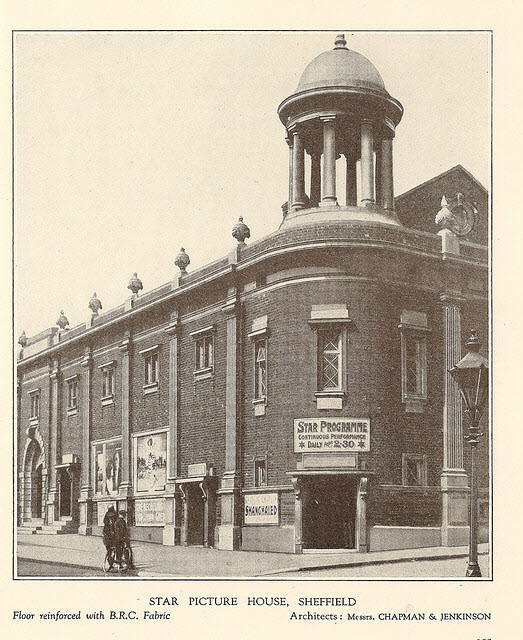
The STAR Cinema on Ecclesall Road, not more than a stone's throw from where I lived. The most enjoyable time was the Saturday afternoon matinee that featured Hoppalong Cassidy, Roy Rogers, The 3 Stooges and Flash Gordon. The black door in the bottom of the photo is where I and some of my friends of about 8 years old used to sneak in without paying.
A FUTURE MUSICIAN? I DON'T THINK SO!
When I was about 9 years old one of these appeared in our small living room:
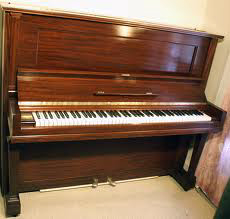
And my mother issued the order- " You are going to learn to play the piano".
Over the next three years I was sent to lessons, once a week, to a teacher who lived on Pomona St. What a waste of money! My mother would make me practice every day before being allowed out to play - I hated it.
I now firmly believe that if a person is going to play a musical instrument they must have some natural inherent talent. I had none and was eventually allowed to give it up. In later life I did have another go at reading piano music but with little success.
Earlier I mentioned Mrs Gillam and her daughter Anthea. Looking back I think saw a lot of Anthea on a sort friend/girlfriend relationship - I'm not sure what you would call it because of our age difference. I've only brought it up again because you will see in the next photo that I'm still with her years later:
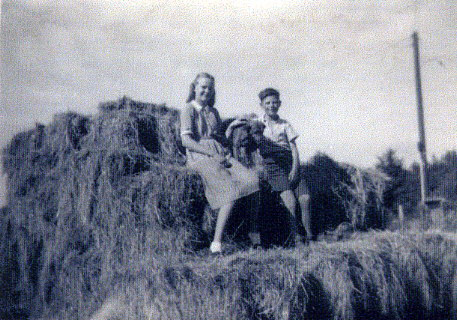
Here, we are on a farmer's haystack (with Rex) at my parent's caravan at Long Line, Dore, already described in my father's life account.
As mentioned in the accounts of my mother's and father's lives we frequently holidayed in Blackpool in the 1940's so I'll not repeat it here, other than show a few photos:
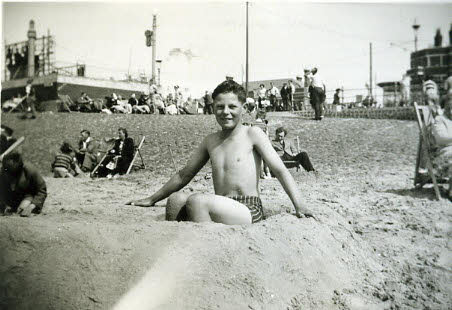
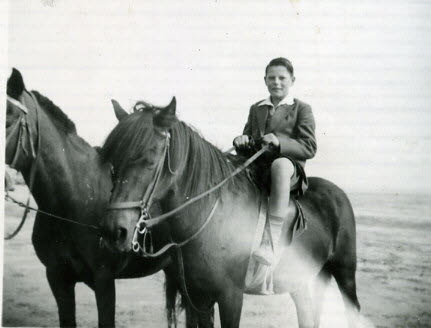
Some times we would holiday with relations:
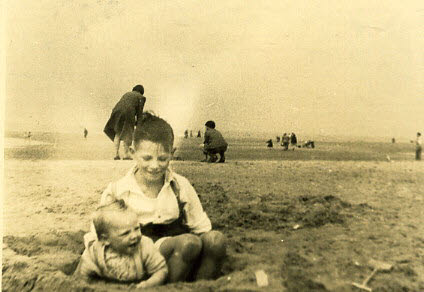
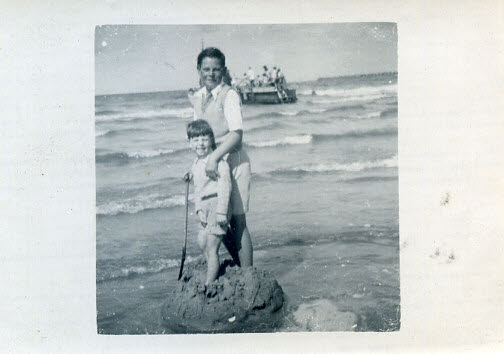
These two are with my younger cousin Malcolm McLean
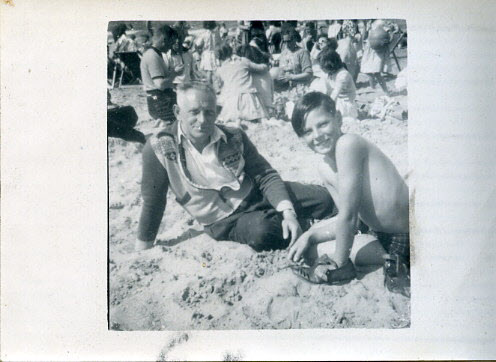
You should by now recognise my father but you may just wonder why this photograph has such a wide white margin. Well I know the reason and I left it deliberately. My father had several hobbies and one was photography. Whenever you see a photo with this sort of margin you will know that it was developed by him. Developing your own photos in those days was quite difficult and time consuming. First you needed a dark room, well he had one of these, THE CELLAR. Down there he had a load of chemicals and trays, including a huge contraption called an enlarger.
After the negatives had been set he would print them and hang them up with clips on a line of string. For some reason the finished print didn't always fill the paper.
Now I've mentioned the word "cellar" some readers may need further explanation. Most houses in the country had a cellar for one main reason- to store coal. Central heating was a rarity and houses were heated by open fires, often every bedroom had one. These cellars were pretty dark and damp places and if it rained heavily it was not unusual for them to flood and water come right up to the top step.
GANG MEMBER
Oh yes! I was in a gang and given the title by others of Gang Leader as I was pretty tough in those days and never lost a fight. The most serious fight I was involved in was with a lad called Johnny Jackson who lived on Hodgson St. After school he was making fun of a girl in our class who was slightly backward and for some reason I thought it necessary to support her. Well, a fight ensued at the corner of Pomona St. and Pear St, and there was a great deal of blood - all coming from the other lad. I remember it was me who called a halt to the fight because his face was in such a mess - even so the brave lad would have carried on.
I also remember, that evening, hiding in the cellar fully expecting his father to come round to our house after seeing what I had done to his son.
After my father had finished keeping chickens I converted the chicken shed into our Gang Hut. We had a table and chairs, carpets and even an old cast-iron stove like you see in the Western movies. I used to take coal from our cellar and burn it to keep us warm in the winter. There was a lock on the door and you had to know the password to get in. This was necessary because things happened in this hut that we kept from our parents. For instance, we used to collect discarded fag-ends from the streets. We would then cut off the burnt end, remove the paper and retain the tobacco. When we had enough we would roll new cigarettes and smoke them in the hut.
Another thing we did in this hut involved a money-making scheme I devised. Just up Summerfield Street was St Mathias church that had closed down and was being demolished. Now everyone, including me, knew that churches have stained-glass windows held in place by lead. The year was 1950 and lead was quite valuable. We collected all we could find and took it back to our hut. With the stove on full heat we melted the lead down in an old soup tin. Then, to make lead ingots we poured it into plastic egg-cups I had taken from our kitchen cupboard. When cool these were taken to a scrap metal merchant on Button Lane who gave us a good price for them.
I remember my mother asking me if I knew where dozens of her egg-cups had gone - after each pouring the egg-cups were burnt black and thrown away.
A LOCAL ADVENTURE PLAYGROUND.
Just behind Pomona St School the path leads to a place where I spent many happy childhood hours:
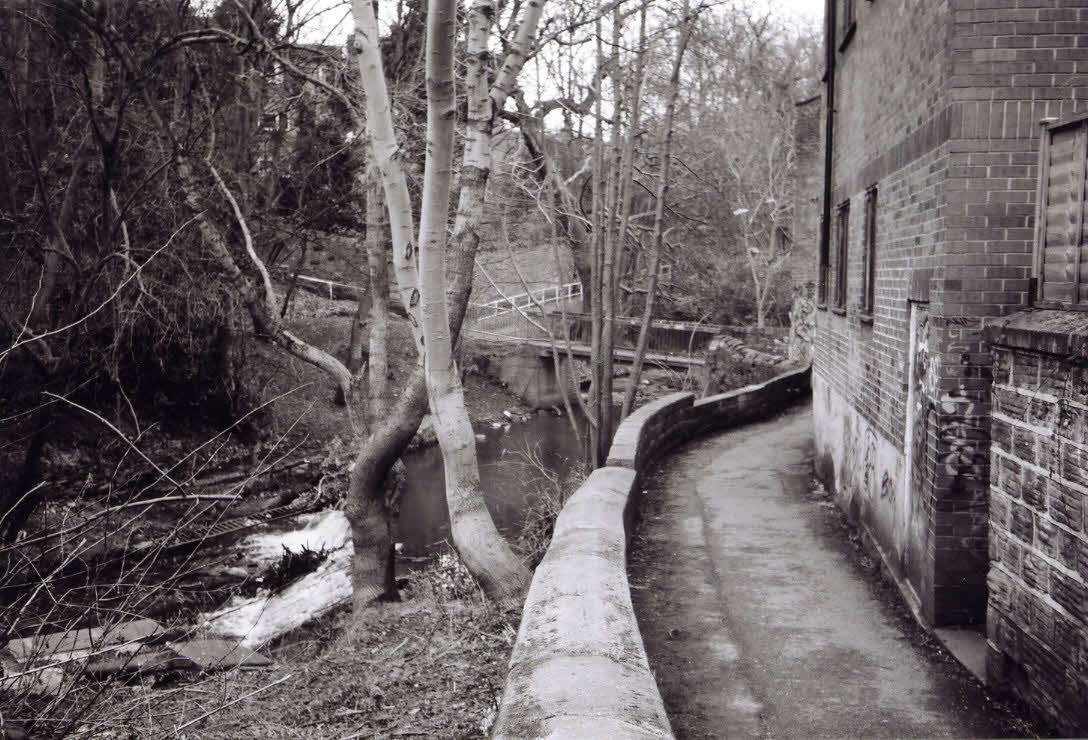
FROG WALK. This was a child's paradise - trees to climb, a river to play in and bridges to swing from. My mother used to say that when I returned home from here it would take her an hour to scrub me clean.
A VISIT TO THE HOSPITAL.
To reach Frog Walk you have to come via Stalker Lees Walk and this is where I had an accident. On one side is a very high wall that backs on to a cemetery:
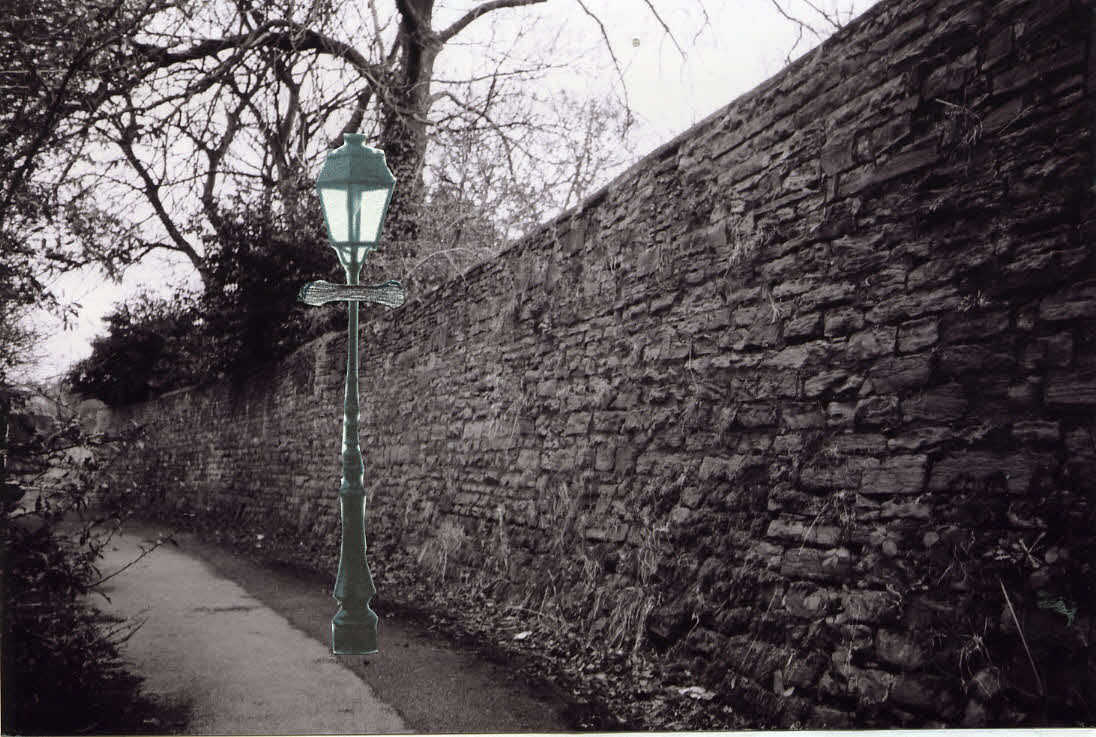
Just a few yards from the beginning there was a gas-lamp. I went back there in 2008 and took the above photo - nothing much has changed over the last 55 years but the gas-lamp is no longer there so I've had to put one in the photo.
When I was about 10 years old several of us went to play in the area. You can see there are plenty of hand and foot-holes in the wall making it ideal for climbing. Well, I climbed the wall and thought it a good idea to leap from the edge, like a trapeze artist and grab hold of the cross-arm on the lamp-post. Unfortunately, my arm weren't strong enough to hold my weight and I crashed to the ground. I walked home, my arm in pain. Our next door neighbough's son took me to hospital in his motor bike and side-car. My arm was broken and put in plaster for six weeks.
AN ENTERTAINING TRICK FOR YOUNGER PEOPLE
Going around in a gang in the evening needed something exciting to do. This is just one of the things we did:
We would select a house up Pomona St. and fasten a piece of black cotton to their window frame:
A few inches from this pin was secured a button.

We would then take the other end of the cotton and hide behind bushes on the other side of the street. A few pulls on the thread would click the button against the glass and bring out the occupant. Finding no one there they would go in. We would start the clicking again and out they would rush completely baffled. Only one did some clever chap find my set-up and start to follow the cotton. It was then time to scarper - we were all good runners and never got caught.
MY BEST FRIEND
Living at 225 Ecclesall Road, just below the Pomona Pub, was the Bedford family:
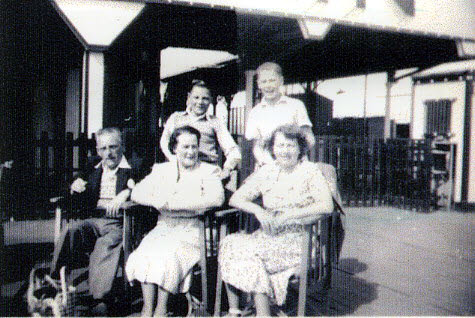
During the early 50's our families became very friend.ly. Their son, Brian, like me, was an only child and a strong bond developed between us. Brian's parents were very tall and although he was a year younger than I he quickly overtook me in height. Throughout the 1950's we saw each other almost every day. We were pretty law abiding lads but I remember one day when we could have been in serious trouble.
We both had a liking for fizzy pop and just above Pomona St School on Stalker Lees Road was a company that produced bottled pop. Brian had the idea of sneaking inside to see if we could get ourselves a few free drinks. I don't know if I was "chicken" or concerned that this was deemed as "breaking and entering" but I said I would wait outside. Well, it was dark and Brian climbed up on the roof and disappeared. A few minutes later all hell broke loose when a night-watchman discovered him. Brian appeared on the roof again and leapt off from a height that should have broken both his legs. He landed cleanly and we set off running and made our escape.
A NORFOLK BROADS HOLIDAY
At the corner of Summerfield Street and Ecclesall Road, where the Kwik Fit tyres is today, there used to be Middleton's Fish & Chip Shop. David Middleton, a year younger than I, who was another close friend of mine, lived there. Several of us would sit on the chip shop wall with three penneth of chips. ( 3 pence was about 1.25 pence in today's money).
If you don't already know and are interested here is a description of pre-decimal money:
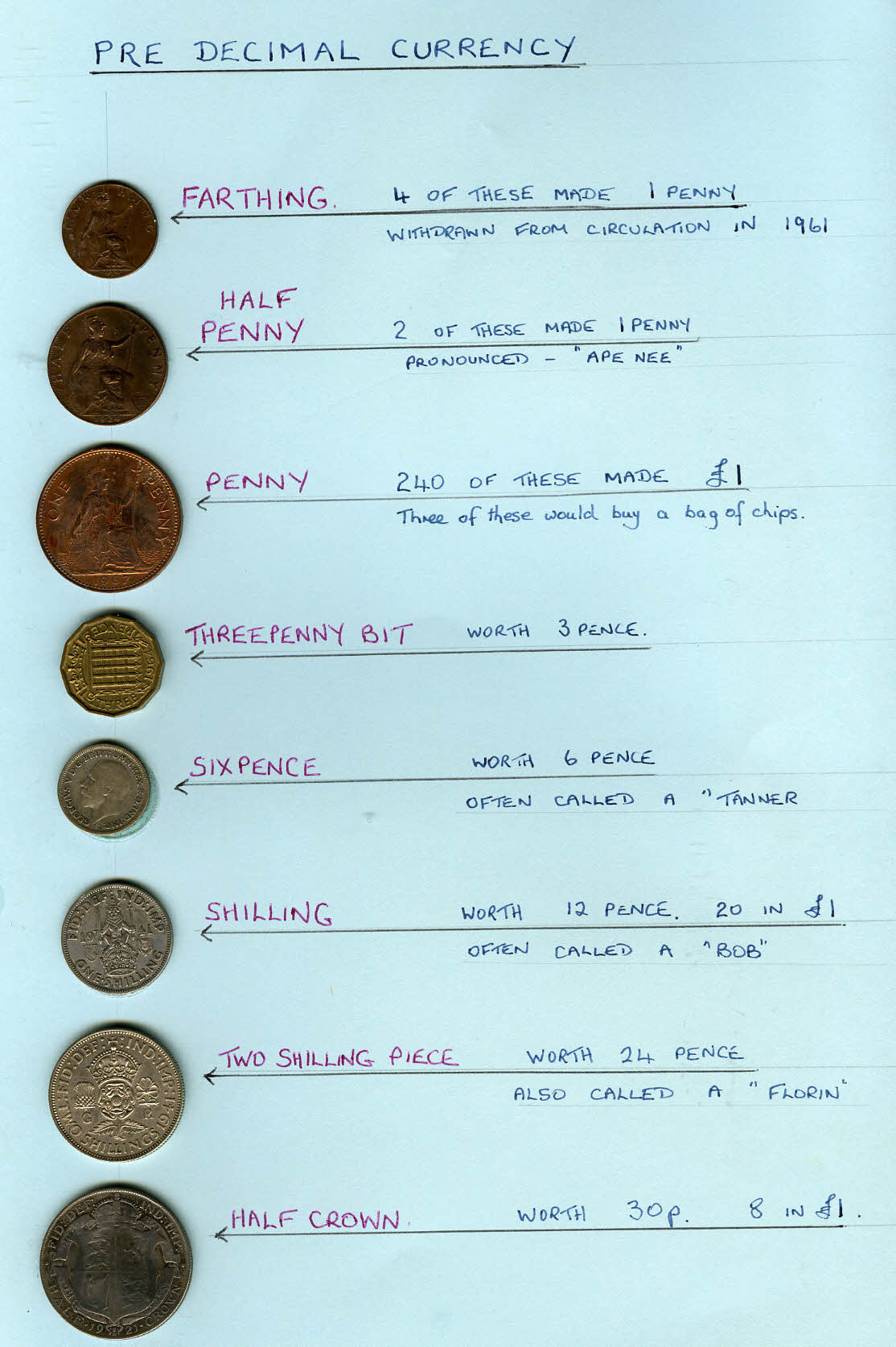
Continuing with the story it was 1950 and I was 11 years old. David's mother and father took me with them on a holiday to the Norfolk Broads in their FORD ZEPHUR:
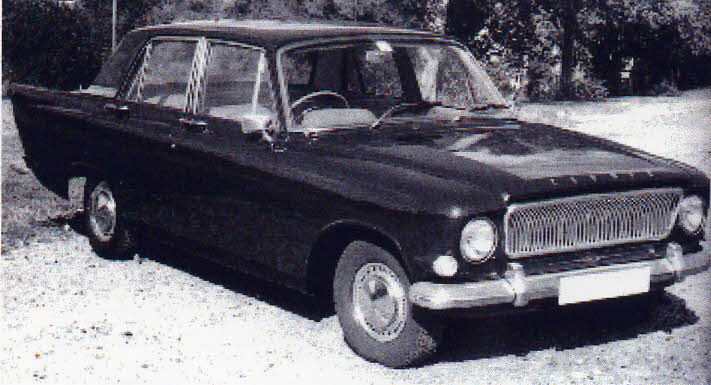
One of the more expensive models of cars available at that time.
We stayed in a high class hotel and Mr Middleton had rented a small boat with an out-board motor that only David's father was allowed to control. Well one day we decided to take the boat out without Mr Middleton knowing. We soon got the engine going and set out on the waterways. Before long we saw a huge boat called the "Queen of the Broads" coming towards us. Now our little boat appeared to be much faster than the larger one and we aimed to prove it. We literally ran circles around the other boat, cutting across the front of it down its side, then round its stern and back up to its front.
When we arrived back at the harbour we got a shock. The pilot of the other boat had reported us to the Harbour Master who went to see Mr Middleton. We were both put to bed at 4 o'clock in the afternoon as a punishment.
SCHOOL FOOTBALLING DAYS
My friends and I all liked to play football and we played most days in our back lane. I became quite good with all this practice and easily got into the school team:
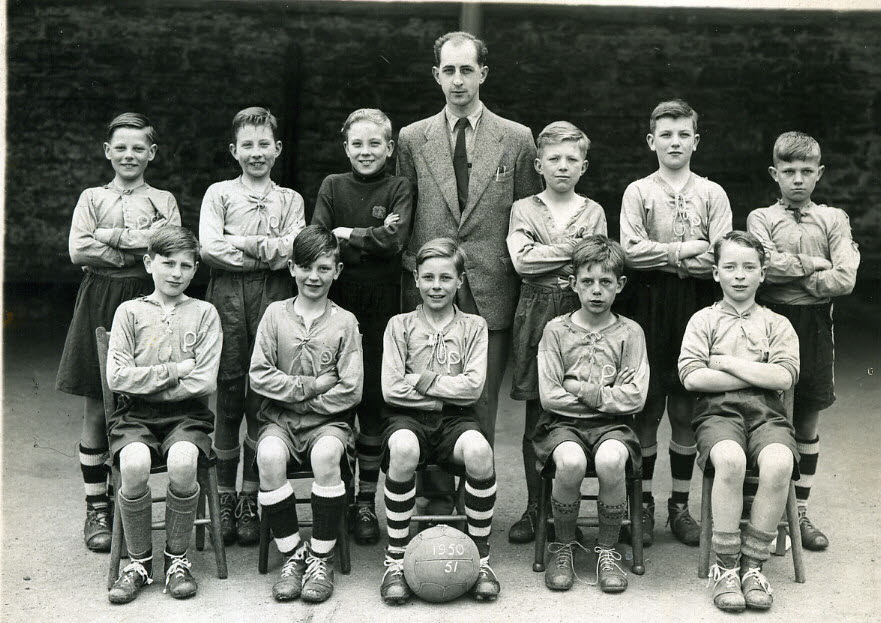
If you can't find me I'm top row far left. My position was centre half.
I'm basing my claim to have been good at the game on the fact that three of us from this team were asked to play additional matches in the school team a year above us:
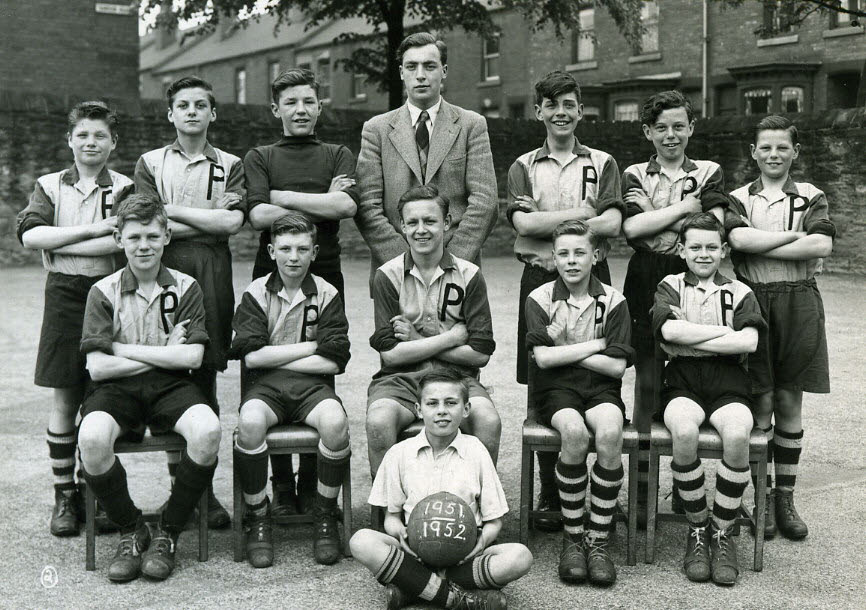
I'm on the back row far right.
GETTING AROUND IN MY EARLY YEARS
Unlike today virtually all children would walk to school up; to a mile without seeking public transport.
When we did need transport for longer distances this is what we used:
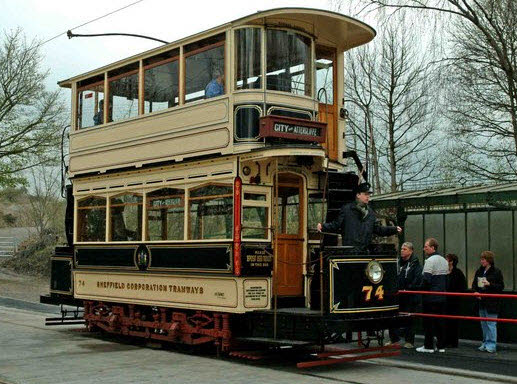
I clearly remember boarding trams as old as this one in the late 1940's and 50's. I can still remember a typical fare for children - it was 1/2p (half a penny). To give you an idea how little this was there were 240 pennies to the £ so the fare was 1/480 of a £ or in new decimal money 0.21 pence
More modern trams were introduced like this one:
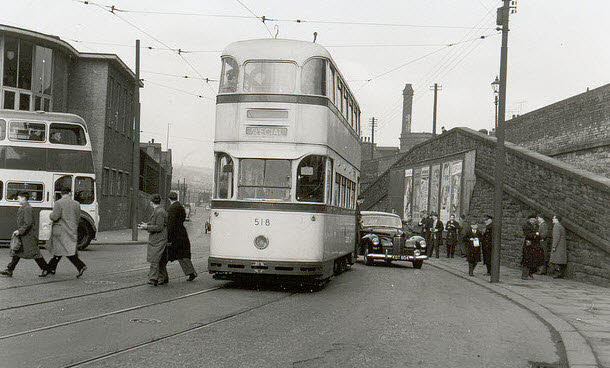
Deep snow was no problem to them even going up steep hills. They were taken off the roads in 1961.
While we are on the subject of money I'll just say that at this time I was given spending money, but it was never enough. An easy way of getting a little more was to find a job. My fist was delivering meat orders on my bike for Ted, the butchers, whose shop was on Ecclesall Road just round the corner of Summerfield Street.
Then I took a job here:
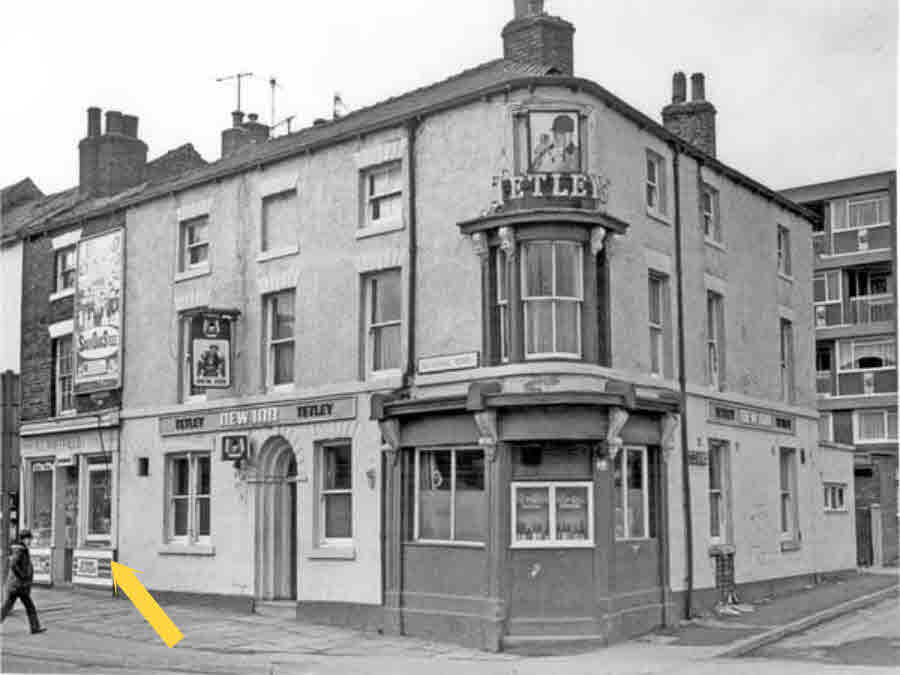
Whitfield's newsagents, on the corner of Ecclesall Road and Hanover Street where I delivered morning and evening newspapers. The evening round paid 6 shillings a week ( 30p ) and the morning round paid 6 shillings and 6 pence (32.5p). My morning round started at 6.30am and I had to visit the shop three times because there were too many papers to carry in one go. When I left the owner, Mr Whitfield, told my mother that I was the most reliable paperboy he had ever had. I never missed a single round.
To continue the next phase in my life CLICK HERE or tab back.
test